Gerry Adams's Blog, page 27
March 19, 2020
SOLIDARITY
There is only one issue to write about this week. The Coronavirus is dominating the news agenda and conversations in homes, among those at work, on social media and in every other way human beings communicate. It’s all about Covid-19 – Coronavirus. So what can I write about it that hasn’t already been written? Not a lot probably. But that never stopped me before.To begin let me say that we need to follow the science. We need to take the advice of the experts and ignore all rumours and unverified information. We can stop the virus from spreading or minimise the spread by washing our hands properly and often and by minimising our close contact with other human beings. That doesn’t mean we shouldn’t get into the fresh air or take a good walk. It doesn’t mean we cut ourselves off completely from everyone else. Unless we have the virus of course or unless we have had contact with someone who has it.We also need to stay calm. It’s easy to get stressed especially because of the wall to wall coverage. So try to avoid any news coverage or conversations which make us anxious. Don’t spread the anxiety. Try to help neighbours and friends. Show solidarity.All this will pass. If we take proper and appropriate precautions we will minimise its effects. We as a species will survive it. Of that there is no doubt.Decisive leadership will enhance and maximise our ability to do this.How governments in Europe, in London, Dublin and the USA are responding to this health crisis has become a source of great controversy. In the North the decision of the First Minister and of the Ministers of Health and Education not to close schools, colleges, universities and public buildings in line with the South caused considerable outrage. Their stance mirrored that of the Johnson government in London. It’s so-called ‘herd immunity’ strategy has been widely criticised The British approach is at odds with that taken by the Irish government, by Italy, France, Spain, Germany and others. They have taken initiatives to restrict movement, increase testing, while encouraging citizens to stay at home and adopt a more rigorous hygiene regime. It makes sense for the two governments on the island of Ireland with responsibility for the health and welfare of citizens to co-operate in erecting barriers to the spread of the virus, including a lock-down of institutions and public places; facilitate testing; co-ordinate medical resources and so on. This is not, as some have spuriously claimed, about the promotion of a uniting Ireland agenda – it is about recognising the interconnected nature of our two jurisdictions, the overlap between communities and the fact that we live together on a small island.All of this is very important and necessary. So is positivity. Social media images of citizens in Italy and Spain standing on their balconies singing and applauding each other is evidence that in the midst of a human crisis people have the courage and spirit to rise above the fear and uncertainty. We also should appreciate our health workers. They are the heroes and heroines of this time, of all time. Compassion, caring, a willingness to help others is a fundamental part of who we are as human beings. It takes real courage who risk contamination by working closely with those who are afflicted with this virus. We have a lot to be thankful for. If we learn anything at all it must be the need for a properly funded and fully resourced public health service. We should also be grateful that we are not as badly off as others who are confronted by disease in other parts of the world.Every year hundreds of thousands of men, women and children die from treatable and preventable diseases. In 2017 one and a half million people died from diarrheal diseases globally. One third – over half a million – were children. In our own place at this time a huge emphasis is being placed on the simple act of handwashing. The World Health Organisation says that handwashing with soap and decent water would have led to a significant risk reduction of 65%. Hundreds of thousands of lives could be saved by soap and clean water. But for these human beings there is no soap. There is no water of a decent quality. Why not?Every day over twenty thousand people die from hunger and three thousand die from preventable malaria. Why?Last week a shipwreck off the coast of Libya brought the known death toll among migrants trying to cross the Mediterranean Sea to twenty thousand since 2014. It is likely that many more have drowned without their deaths being known. According to the International Organisation on Migration, “two-thirds of the fatalities we have recorded are people lost at sea without a trace”. These are just some of the human crises, along with climate change and war and natural disasters which continue to take the lives of people every day across the world. These global crises demand a global response. So, it is important as we meet the challenge of Covid-19 that we do not forget those others who are less fortunate that us.
Published on March 19, 2020 04:56
March 13, 2020
Chieftain's Walk Postponed
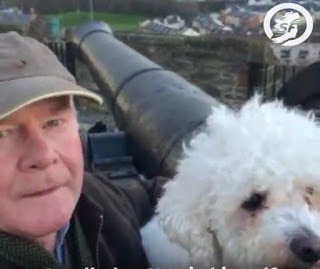 Martin and Buttons on Derry's Walls
Martin and Buttons on Derry's Walls
Chieftain’s Walk postponed
I wrote this blog and it was published by the Andersonstown News on Wednesday. However, the crisis created by the Coronavirus led Martin’s family to postpone it.
This is their statement and below is my blog.“The family of Martin Mc Guinness have taken the ‘difficult but necessary’ decision to postpone this year’s 2020 Chieftain’s Walk amid the concerns over Coronavirus, it has been confirmed.
Announcing the decision, Fiachra Mc Guinness said: “As a family we want to thank everyone who has already registered for this year’s Chieftains Walk which had been scheduled to take place on March 29th.
“As ever, we gratefully appreciate your support and it has been a difficult decision for us to take to postpone the event.
“However, in light of the ongoing situation regarding Coronavirus, we also feel it is a necessary decision in order to play our part in helping to prevent the spread of this virus.
“It is our firm intention to reorganise the Chieftains Walk as soon as practically possible, registration remains open, and further details will be announced when they are confirmed.
“For now though, we would reiterate our thanks to all those who have registered and supported the Chieftains Walk over the past two years. It remains a great source of comfort to us as a family.”
The Chieftain’s Walk.Martin McGuinness died on 21 March 2017 from amyloidosis – a genetic disease. The following year his family and friends came together and organised the first Chieftain’s Walk to raise money for the Cancer Centre at Altnagelvin Hospital. This year’s Chieftain’s Walk will be on March 29th.I joined with thousands of others in that first walk. We started at Glenowen in Derry and walked the five and a half miles to the Stone Fort of Grianán of Aileach on the Inishowen peninsula. If you have never visited Grianán put it on your to-do list. It’s a five-metre-high, four-metre-thick circular wall which gives an amazing view of Lough Foyle, and especially of Inch Island and Lough Swilly.It was one of Martin’s favourite places. He went there many times. He was especially fond of the skyscape when on a clear night billions of stars and galaxies shine down on Donegal. Many a time he and I walked out the Groarty Road to Grianán. Whatever the weather. It is a dramatic and spiritual space. A place of quiet beauty. So, for me Grianán is forever tied up with Martin McGuinness.Martin’s family have their roots in Donegal. Na hUilli, anglicized to the Illies, north of Buncrana, on the Inis Eoghain peninsula. Inis Eoghain and Derry are on opposite flanks of that same broad finger of high ground between Lough Swilly and Lough Foyle. The British border winds its invasive unwelcome way through this beautiful landscape creating two separate jurisdictions and separating County Derry from County Donegal.It was on Inis Eoghain that Martin spent his childhood summers. When Martin and Bernie got married it was in Cockhill chapel, outside Buncrana. It was there that Martin got Colette and I the use of a caravan for me to recuperate in after I was shot and wounded in 1984. So I also got to know the magic of the Inis Eoghain peninsula.Martin was also very much a child of Derry. He loved the City, its places and people. He was born in 1950. As a young person growing up in Derry in the 1950s and 60s Martin was no more interested in politics that everyone else his age. He had the same interests as everyone else his age. But politics intruded on his life. He was part of a nationalist community that lived in a unionist dominated apartheid state. A state that did not want Martin or his family or his community. In a City that had become a byword for electoral gerrymandering and discrimination. The civil rights movement was born out of this injustice. Derry was in the vanguard of the campaign for justice. Like many other young people Martin took part in the civil rights marches. He witnessed at first hand the violent response of the unionist regime and its paramilitary forces. It was into this maelstrom that a young Martin McGuinness and many other Derry wans bravely stepped. It was this Martin McGuinness - young, idealistic, courageous, a leader – who I met for the first time behind the barricades in Derry. His politics were shaped by the Derry experience, by his love of Derry and by his mother Peggy’s homeplace in Inishowen.There was a ready warmth in his smile. A genuine openness and a pleasant, unpretentious personality. In the years that followed Martin and I shared many adventures and memorable times. Some funny, some not.During the battle of the funerals I remember him in Milltown Cemetery - when we were surrounded by lines of battle wielding, riot clad RUC men –telling everyone to turn round and face them. To look them in the eye. Not to be afraid. To remember that they were the oppressors and that it was we who desired freedom and justice.When Michael Stone attacked the Gibraltar funerals 32 years ago this month Martin was there helping the wounded, bringing calm to a dangerous situation. He was fearless. He was a leader.It was he who was our representative in the secret talks with the British government in the early 90’s. He led the first Sinn Féin delegation to the British at Parliament Buildings in December 1994. He was in the first republican delegation to hold talks in Downing Street in December 1997. He was our Chief negotiator – the man who sat across the table from British Prime Ministers and Ministers and Unionist representatives and argued for change.On one occasion in 2002 during a meeting in Tony Blair’s inner office in Downing Street Martin forcefully told him not to invade Iraq. Martin told him that if he thought the war in Ireland was bad invading Iraq would be so much more. We both urged Blair to turn back from what would be a disastrous course for the people of that region and for Britain. Blair ignored us.In March 2007, after several years of difficult negotiations, Ian Paisley joined Martin and I in a press conference at Parliament Buildings to announce we had a deal. Two months later Martin and Ian Paisley and became joint First Ministers. In the years that followed Martin made a remarkable personal and political journey, first with Paisley, then with Peter Robinson and then with Arlene Foster.He remained a steadfast republican, unbowed and unbroken throughout his life of activism. He never deviated from his republican principles; his belief in the unity of the Irish people in a free, independent, united Ireland; or in his humanity. He always did his best – he gave it one hundred percent.So join us and Bernie and the McGuinness clann on The Chieftain’s Walk on March 29th.The funds raised will go to the Martin McGuinness Peace Foundation which was established in his memory. The Foundation will celebrate Martin’s life, work and achievements by promoting his aims of reconciliation; unity and peace; social and economic change; rights; equality; inclusivity and diversity and community empowerment through an inclusive program of education, sport, debate, art and culture which will be open to all.This year’s Chieftain’s Walk will have a new route from previous years. Martin was very fond of walking along Derry’s Walls. It wouldn’t have been unusual to see him walking along the walls with his dog Buttons. The Chieftain’s Walk will begin at 1.30pm at Westland Street, walking along the Derry Walls and finishing at the Long Tower Centre.Bígí linn.
Published on March 13, 2020 03:54
March 5, 2020
Micheál Martin fails the Coca Cola test
There have been some surreal moments on the back of the recent election results as the political and media establishment in the South tries to come to terms with Sinn Fein emerging as the largest party. Acting Taoiseach Leo Varadkar tried to portray the series of Townhall meetings that the Sinn Fein leadership has been holding as the next stage of a “campaign of intimidation and bullying”. One after another acting Fine Gael Ministers took to Twitter to tell citizens that Sinn Féin shouldn’t be holding meetings. Whoever is advising Fine Gael is doing a great job for Sinn Féin.The accompanying extensive media coverage following Varadkar's accusation and the criticism by his Acting Ministers did more to advertise our events than anything we could have possibly done. As a result all of the meetings were standing room only. The Liberty Hall meeting was especially memorable as Pearse Doherty – in fine voice and form – stood outside on a cold February evening and delivered a riveting speech to the overflow crowd.Micheál Martin predictably lost the run of himself in the Dáil when it met to elect the Taoiseach. Having already lost the popular vote to Sinn Féin and been pushed into second place in the vote for Taoiseach by Mary Lou, Martin’s diatribe against Sinn Féin reflected his obsession with us. It was a regurgitation of all the bile he has spouted over recent years. Eoghan Harris, who could have written the speech, extolled Martin’s verbosity in his Sunday Independent column. Martin’s speech was he said; “a magisterial speech whose historic important was missed by most of our craven media.” I was definitely listening to a different speech! Harris and the Sunday Independent are renowned for their vitriolic attacks on John Hume during our efforts to construct a peace process in the 1990’s. Last week Micheál Martin said: “If you listen to the dishonest narrative from Sinn Fein you would imagine we have had Ministerial positions for the last nine years. Between 2011 and 2016 we had 20 seats. Hardly the establishment party of that period ... In 2016 until now we weren’t in government. These are the facts.” But everyone knew that in partnership with Fine Gael, Micheál Martin had agreed a Programme for Government; negotiated and agreed four budgets, which punished workers and their families; elected two Fine Gael Taoisigh (Enda Kenny and then Leo Varadkar); and despite public outrage over the crisis in homelessness, housing and health Martin ensured that no-confidence motions in the Dáil against the two responsible Minister’s failed. He also opposed discussions in the Dáil to plan for Irish Unity. In this election the electorate saw through all of this. Consequently, instead of the 50 plus seats he confidently expected Micheál Martin lost seats and returned 37 TDs.In addition, during the course of the election Micheál Martin pledged that Fianna Fáil would not go into government with Sinn Féin or Fine Gael. He now claims he has a mandate from the electorate not to speak to Sinn Féin about government. However, last week he met Acting Taoiseach Varadkar and appears willing to ignore his equally strong mandate not to go into government with Fine Gael! Clearly, it’s not about change. It’s about holding on to power.Micheál Martin’s attacks on Sinn Féin are not new. Since 2002 when Nicky Kehoe almost won a seat in Bertie Ahern’s - then Taoiseach – constituency in Dublin Central, Fianna Fáil leaders have been worried about the potential electoral threat posed by Sinn Fein. Their claim to be ‘ The Republican Party’ doesn’t sit well because Mr. Martin fails the Coca Cola test. When faced with the choice between Sinn Féin and Fianna Fáil citizens are increasingly going for the real thing.For example, three years ago Micheál Martin announced that Fianna Fáil was going to produce a 12 point plan on Unity. Like the promise to contest seats in the North it has yet to happen. Their general election manifesto did not contain any meaningful unity proposals. In the almost ten years I was in the Dáil Micheál Martin used every opportunity to attack Sinn Féin. Facts are irrelevant. The crisis in the North was shamefully exploited time and time again. At Arbour Hill in 2015 he claimed that Sinn Féin was not fit for government. In September of that year he called on the Irish and British governments to suspend the Good Friday institutions. When the institutions did collapse in 2017, because of the Renewable Heat Incentive scandal and the actions of the DUP, he repeatedly claimed, despite knowing where the blame really lay, that he couldn’t “comprehend” why there was no Executive and Assembly. This from a political leader whose long tenure in various Ministerial roles saw Fianna Fáil Ministers accused and some convicted of corruption. He did nothing about this.Instead of constructively engaging as the leader of Fianna Fáil to find solutions he has spent his time demonising Sinn Féin. His accusations around so-called ‘Shadowy Figures’, despite his relationship with some of these, is one example of this. Nor can we separate this Fianna Fáil and Fine Gael demonization strategy against republicans from the recent threats against Mary Lou McDonald, Michelle O’Neill, and Gerry Kelly and the two attacks in Belfast.The real reason for Micheál Martin’s hostility to Sinn Féin was given by him many years ago in an argument he had with Martin McGuinness during negotiations at Hillsborough Castle. An angry Micheál Martin said: “You won’t do to us what you did to the SDLP.”The Fianna Fáil/Fine Gael objective is to persuade public opinion that Sinn Féin cannot be trusted in government. If they fail to agree on a coalition – a carve up of political power - and a second election is called their negative campaigning will intensify. In fact the establishment is fighting that election now.Micheál Martin and Leo Varadkar are not about change. They are not about tackling the needs of the growing numbers of homeless, or those on trollies or the increasing hospital waiting lists, or a United Ireland. They are about trying to sustain decades of power and influence. They are about defending a status quo that many want to change. As Mary Lou expressed it in her speech in the Dáil which has now been viewed over two million times: “If you keep reaching desperately for the past, it means you are not up for the future.”So Fianna Fáil and Fine Gael are content to confront Sinn Féin about the past. Their refusal to talk about the future with us, or to acknowledge the right of our voters to be represented at such discussions, is shameful.Now the Fianna Fáil leader is telling Unionists that it’s ok for them to be in government with Sinn Fein in the North but that Fianna Fáil or Fine Gael are too good to do that in the South.You can fool some of the people some of the time but ...
Published on March 05, 2020 06:41
February 27, 2020
IF YOU WANT TO GET AHEAD GET A HAT.
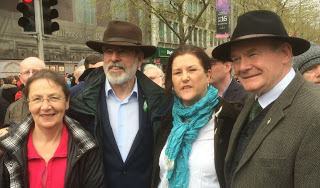
Bairbre de Brún, Mise, Lucilita Breathnach and Martin at the centenary celebrations in Dublin 2016
I like hats. And caps. I have quite a nice collection of headwear, worn and aged, like myself, dispersed between Dublin and Belfast, Donegal, the car boot and all the places in between. It used to be customary for men to wear headware. Look at any old photos. Dunchers and flatcaps galore. Peaky blinders in multitudes outside factories, mills, shipyards, farmyards, public houses, marts, markets, country fairs. Hats were also popular. Paddy hats, trilbys, bowlers. Though bowlers were more for Orangemen on parade or English civil servants on The Mall. Country men were hat and cap people. Christy Ring even played hurling in a cap. So my grá for head gear used to be widespread. And now its coming back into vogue. Especially the omnipresent baseball cap. It is the preferred head covering for rappers, golfers, other sports people, urban youth.
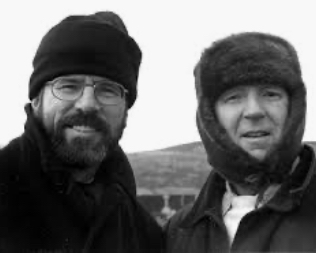 Mise agus Cleaky
Mise agus Cleaky
I have a couple of baseball caps. And a few hand knitted wooly hats. Síle Darragh knitted me a dark blue Tea Cosy type one. Lucilita a white one. Both were too big. But very warm all the same. Wooly ear warmers. There are really fine knitted yokes for sale in expensive shops in the west of Ireland. But they are very dear. I covet one of those. Hint hint. Extra Large.
I also have a Stetson. It was presented to me in Texas. It has an enormous brim. I only wear it indoors, usually while watching Westerns on TV. I haven’t the nerve to wear it outdoors. Before the presentation our man in America, Larry Downes, was very concerned that the Stetson should not be a black one. Apparently the bad guys wore black ones. So he insisted that my Stetson would be white. So it is. I never told Larry but I preferred a black one. I favour Jesse James or Billy the Kid over Hopalong Cassidy or The Lone Ranger. But Larry had his way.
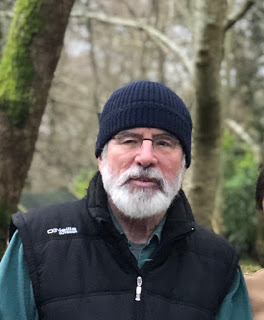 I have another hat which I’m also shy about wearing outdoors although I like it very much. It’s not unlike the one Martin McGuinness wore during the Easter Centenary events. I wore mine as well. I would like to have the nerve to wear it more often the way Martin started to do. Martins hat now features in many posters and pictures of him. I think the hat darkens his face too much and he looks too stern. He was stern sometimes but my best memories of Martin are when he was hatless and happy.
I have another hat which I’m also shy about wearing outdoors although I like it very much. It’s not unlike the one Martin McGuinness wore during the Easter Centenary events. I wore mine as well. I would like to have the nerve to wear it more often the way Martin started to do. Martins hat now features in many posters and pictures of him. I think the hat darkens his face too much and he looks too stern. He was stern sometimes but my best memories of Martin are when he was hatless and happy.One day he and I were going to see Brit Secretary of State Peter Mandelson. On the coat stand outside his office a hat was perched. To Martin’s chagrin I put the hat on my head and we breezed in to talk to Peter.
“I have a hat like that” Peter told me cheerfully. “I wear it in the grounds of Hillsborough House”.
“If you want to get ahead get a hat” I replied, removing it and placing it on my knee. “You have very good taste in headware. That’s something we have in common.”
When we finished our meeting I put Peter’s hat back on my head and Martin and I left.
“You can’t take his hat” Martin hissed at me “That’s stealing”.
“Stealing! They stole our country” I said. “In the gospel according to Cleaky, I’m liberating it. This is appropriating the Imperialist Misappropriators”. Cleaky was a great liberator. An outstanding appropriator.
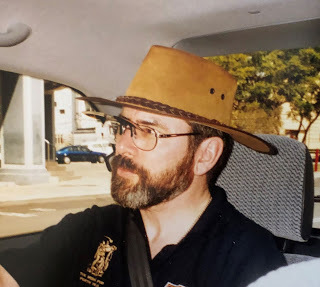 One time in Australia John Little gave RG and me some fine head covers. We picked up two Koalas as well. Ach is é sín sceal eile. But that’s another story. No Koalas were harmed in the telling of this tale.
One time in Australia John Little gave RG and me some fine head covers. We picked up two Koalas as well. Ach is é sín sceal eile. But that’s another story. No Koalas were harmed in the telling of this tale.I like tweed caps. I have one which belonged to my friend the late Kevin McKenna. We swapped caps one time. I wear Kevin’s cap regularly. I also have a cap belonging to another friend, the late Stan Corrigan. His lovely wife Kathleen gave me it. It is that cap which triggered this column. I lost it last week after the recent Ard Chomairle meeting in Dublin which mandated Mary Lou to explore the possibilty of agreeing a Programme for A Government For Change.
I was distraught about the loss of Stan’s cap. I realised very quickly after the meeting that it was missing. But where? I enlisted the help of Saint Anthony. Again.
Was it in Dawn Doyle’s car? No she told me when I phoned her. Or out the back of Ard Oifig where RG picked me up? No. There was no sight of it when Keith searched the back lane in the dark in the midst of Storm Ciara.
Next morning the search continued. I prowled the back lane of Ard Oifig before being summoned heartbroken into a meeting. While I was so engaged, that darling man Mick O Brien drove back to the CWU building where the Ard Chomairle met.
He returned triumphantly.“I have your hat” he declared and handed me a Russian Cossack type piece of hairy millinery.
“That’s not my hat” I told him as I tried it on.
“It’s lovely on you” Mick told me. And so it was.
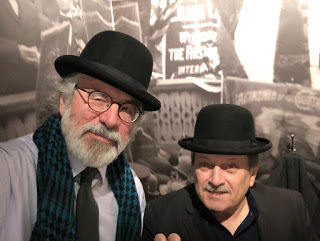 But I was still fretting for big Stan’s cap. Negotiations for Government? The Sinn Féin surge? The posturing by Fianna Fáil and Fine Gael’s leaders? Shadowy friggers running Sinn Féin? I focussed with my comrades on all this but beneath my new, well nearly new, Cossack hat my wee mind refused to give up on big Stan’s missing cap. Apart from the sense of loss how could I face Kathleen? She’s a Tyrone woman. Hell hath no fury like a Tyrone woman chastising a man, particularly a Belfast man. My nerves were wrecked.
But I was still fretting for big Stan’s cap. Negotiations for Government? The Sinn Féin surge? The posturing by Fianna Fáil and Fine Gael’s leaders? Shadowy friggers running Sinn Féin? I focussed with my comrades on all this but beneath my new, well nearly new, Cossack hat my wee mind refused to give up on big Stan’s missing cap. Apart from the sense of loss how could I face Kathleen? She’s a Tyrone woman. Hell hath no fury like a Tyrone woman chastising a man, particularly a Belfast man. My nerves were wrecked.“An bhfuil cead agam dul amach?” I asked Mary Lou. “May I go out?”
“Tá” she said “Yes, but please take off that Russian hat.... and get your hair cut.”
I exited despondently stage left, as sheepishly as Micheál Martin after Mary Lou scalped his arse. Out the back of Ard Oifig the old Dominic Street flats, now demolished, are a building site. I made my way gingerly through the muck. A burly workman greeted me.
“A great election result” he said.
“Yup” I replied, “Did you find a cap?”
“Is it a Bugatti?” He asked.
I wondered if he had a selection of caps. A Malloy. A Hanna. A Magee. But no he only had one. Stan’s Bugatti. He pulled it out - a grey wet crumpled item - from beneath his yellow High Vis Vest.
“That’s it” I cried as I resisted the urge to hug him. Instead I told him about big Stan. His eyes welled up with tears.
“I’m glad I found it” he told me.
“You look very like a painting my Granny had of Saint Anthony” I told him.
He looked at me warily.
“Thank you” I gushed.
“No problem. Tell me one thing” he asked.
“Anything” I replied.
“When are you getting your hair cut?” He asked.
“Soon” I told him. After all he did find big Stan’s cap.
He smiled at me and as he turned away I really could see that he looked remarkably like my Granny’s picture of Saint Anthony. I felt an urge to fall on my knees in the muck to offer a prayer of thanks to him but I suppressed this. So instead I just thanked him again. He smiled beatifically.
Now I’ve Mick’s Russian hat as well as big Stan’s cap. It’s great. No need to worry about the wrath of Kathleen. Or Mary Lou. Unlike Micheál Martin. If I had two heads I’d be landed.

Published on February 27, 2020 01:39
February 21, 2020
The Myth Of “Shadowy Figures”
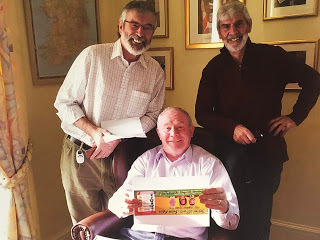 Mise agus Martin and Ted in Stormont Castle 2018The demonising of republicans has long been an integral part of politics on this island, and especially in the lead into and during electoral campaigns. Through the decades of conflict Unionist leaders and British governments regularly posed as democrats while supporting anti-democratic laws, censorship and the denial of the rights of citizens who voted for Sinn Féin. Sinn Féin Councillors, party activists and family members were killed by unionist death squads, often in collusion with British state forces.Successive Irish governments embraced this demonization strategy through Section 31 and state censorship. Sinn Féin was portrayed as undemocratic and dangerous. We were denied municipal or other public buildings to hold events including Ard Fheiseanna. In the years since the Good Friday Agreement these same elements have sought to sustain this narrative. The leaderships of Fianna Fáil, the Irish Labour Party, the SDLP and unionists, have been at one on this. Self-interest has shaped their approach.Fianna Fáil Leader Micheál Martin regularly uses the Dáil to attack Sinn Féin. At one point in September 2015 he called on the two governments to suspend the institutions in the North! When the institutions did collapse in 2017, over the Renewable Heating Incentive scheme and the denial of rights, he changed his tack to one of “not comprehending” why there is no Executive and Assembly in the North.In January Micheál Martin kicked off the current negative campaigning with a claim that Sinn Féin is not a “normal” democratic party. Decisions he said were being made by “shadowy figures”, by an unaccountable Ard Comhairle and by people in the Felons Club and Connolly House in west Belfast. Stupid, yes, but recent loyalist threats and death threats against Michelle O’Neill and Gerry Kelly mean that vacuous claims of “shadowy figures” feeds into a context in which people can be targeted. Previously in the Dáil Micheál Martin identified two of these as Ted Howell and Padraic Wilson. In more recent days Marty Lynch, Sean Murray, and Bobby Storey have all been named. Teachta Martin knows all this to be rubbish.
Mise agus Martin and Ted in Stormont Castle 2018The demonising of republicans has long been an integral part of politics on this island, and especially in the lead into and during electoral campaigns. Through the decades of conflict Unionist leaders and British governments regularly posed as democrats while supporting anti-democratic laws, censorship and the denial of the rights of citizens who voted for Sinn Féin. Sinn Féin Councillors, party activists and family members were killed by unionist death squads, often in collusion with British state forces.Successive Irish governments embraced this demonization strategy through Section 31 and state censorship. Sinn Féin was portrayed as undemocratic and dangerous. We were denied municipal or other public buildings to hold events including Ard Fheiseanna. In the years since the Good Friday Agreement these same elements have sought to sustain this narrative. The leaderships of Fianna Fáil, the Irish Labour Party, the SDLP and unionists, have been at one on this. Self-interest has shaped their approach.Fianna Fáil Leader Micheál Martin regularly uses the Dáil to attack Sinn Féin. At one point in September 2015 he called on the two governments to suspend the institutions in the North! When the institutions did collapse in 2017, over the Renewable Heating Incentive scheme and the denial of rights, he changed his tack to one of “not comprehending” why there is no Executive and Assembly in the North.In January Micheál Martin kicked off the current negative campaigning with a claim that Sinn Féin is not a “normal” democratic party. Decisions he said were being made by “shadowy figures”, by an unaccountable Ard Comhairle and by people in the Felons Club and Connolly House in west Belfast. Stupid, yes, but recent loyalist threats and death threats against Michelle O’Neill and Gerry Kelly mean that vacuous claims of “shadowy figures” feeds into a context in which people can be targeted. Previously in the Dáil Micheál Martin identified two of these as Ted Howell and Padraic Wilson. In more recent days Marty Lynch, Sean Murray, and Bobby Storey have all been named. Teachta Martin knows all this to be rubbish.
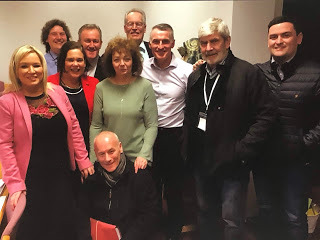
Some of the Sinn Féin negotiation team at Stormont: Michelle O'Neill, Seán MagYidhir, Mary Lou McDonald, Conor Murphy, Pádraic Wilson, Carál Ní Cuilín, Gerry Kelly, Declan Kearney, red Howell and Stephen McGlade The reality is that Ted, Padraic, Big Bob, Sean, and Marty have been part of the Sinn Fein negotiating team for a very long time. Mr. Martin knows some of them. Ted was part of the team which produced the two seminal documents Scenario for Peace in 1987 and Towards a Lasting Peace in Ireland in 1992. At different times he has been part of delegations which met with John Bruton, Dick Spring, Pronnsias de Rossa, Leo Varadkar, Charlie Flanagan, Simon Coveney, Tony Blair, Gordon Brown and Theresa May. He has also met Bertie Ahern, Brian Cowan and Micheál Martin and the DUP and UUP. Ted worked closely with Tony Blair’s former Chief of Staff Jonathan Powell and attended meetings in Downing Street and Hillsborough Castle with Micheál Martin. Pádraic and Marty too were often part of these delegations and often held meetings outside of the negotiating events with senior Irish government officials. Ted and Pádraic also have deserved reputations for the provision of first class meals and pastries during negotiations. We have shared these with some of those above, including with Simon Coveney. Just before Christmas 2018 I published ‘The Negotiators Cookbook” co-authored with Ted and Pádraic and with recipes in the main from both. The Negotiators Cookbook was very well publicised. Ted and Pádraic were widely credited for their culinary skills. Hardly “shadowy figures”.The single most important aspect of the Stormont House negotiation in 2014 was the effort to address the legacy issues. The Sinn Fein working group handling this important issue included Gerry Kelly MLA, Sean Murray, Caral ni Chuilin MLA and Bobby Storey. All former political prisoners. The then British PM David Cameron was present in Stormont House for some of the last hours of that negotiation. So too was Charlie Flanagan. When a roundtable meeting was held to conclude on this issue, Sean Murray represented Sinn Fein. He played a pivotal and constructive role in this as he has in resolving many of the contentious Orange marches which used to create serious difficulties in Belfast.
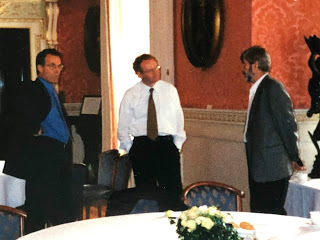 Gerry Kelly, Martin McGuinness and Ted Howell in Weston Park in 2001Irish governments quite rightly celebrate advances in the North. They like to claim some of the credit for advances when they are made. In its Election 2020 manifesto Fine Gael has a whole section boasting of its intensive work in supporting the political parties in North in achieving the recent ‘New Decade, New Approach’ agreement. Apart from Bobby Storey who is unwell, all of those named as “shadowy figures” played key roles in that agreement.All of these activists are well known. They have held senior public and elected positions in the party. Many have had long and fruitful relationships with senior Irish and British government Ministers and officials as we have charted a course from conflict, through a peace process, to an end to conflict and peace.The role of sections of the media is also reprehensible.The Pat Kenny’s, Sean O Rourke’s and Miriam O Callaghan’s interrogate Sinn Fein spokespersons ad nuseaum about these claims. They dominate many interviews. Surely they could have checked the names out. All of the facts set out above about these decent highly respected and hard working republicans is readily available. Some of the media heads involved are old enough to have known the goings on in the Fianna Fail leaderships or the terrible treatment of sections of Irish society, particularly women in the past. With some honourable exceptions the record of the Irish media, and particularly RTE is tawdry on these scandals. So too is their historical coverage of the north. The truth is sections of the Irish media are part of the Establishments cosy consensus. They are against challenging the status quo because they are part of the status quo. Fianna Fáil and Fine Gael have selective memories. Both parties emerged out of conflict and a close relationship to the IRA. Many of their leaders, including Michael Collins, De Valera, Sean Lemass and others, all served time in prison. Some were responsible for acts of violence that mirrored those of more recent decades. Fine Gael’s relationship with the pro-fascist blueshirts is well documented. In the 1990s Fine Gael was in coalition with Democratic Left shortly after that party was formed following a split in the Workers Party. The history of the Workers Party and the so-called Official IRA is well known.During the conflict republicans were challenged and it was demanded of us that we embrace unarmed politics. Protestations by me and other Sinn Fein representatives that this was exactly what Sinn Fein was about were dismissed as was our growing electoral support. Now that some who were political prisoners or former combatants have fully embraced the new dispensation we are being told that this is not good enough. Not only is this stupid, unfair and self serving it also ignores the positive influence that activists from this background have with other republicans. The reason the anti peace process armed groups have so little support in republican heartlands is because men and women of integrity with long records of hard struggle have stood up against them. Incidentally, the two governments accept and work with Sinn Fein elected representative with exactly the same history as those named as “shadowy figures”. I am certain if Pádraic Wilson, Ted, Big Bob or Marty Lynch, Seán Murray or others like them stood for election in their communities they would be elected. As for the role of the Ard Comhairle and elected representatives ? Sinn Féin agrees policy at our Ard Fheis which is entirely open to the media and is widely covered by it. Our Ard Comhairle and party leader are elected at the Ard Fheis. Very democratic. Very public, very open. One Fianna Fáil TD John McGuinness rebutted his own leaders claims. He said that the decision making process in Fianna Fáil is similar to that of Sinn Féin and he said: “I find it strange that they would say that [Fianna Fáil] TDs are consulted – sometimes we are not consulted at all.”That’s probably true of all these parties. But there is no media scrutiny of the small group of advisers who aid Micheál Martin. Who is Deirdre Gillane or Pat Mc Parland or Sean Dorgan? I’m sure they are decent people doing their best by their own lights. I might not agree with them but I have no reason or desire to cast aspersions upon them. Ditto with Leo Varadkar’s team. So thank you Ted, Pádraic, Marty, Séan and Big Bob and all the other “shadowy friggers”. Onwards and upwards.
Gerry Kelly, Martin McGuinness and Ted Howell in Weston Park in 2001Irish governments quite rightly celebrate advances in the North. They like to claim some of the credit for advances when they are made. In its Election 2020 manifesto Fine Gael has a whole section boasting of its intensive work in supporting the political parties in North in achieving the recent ‘New Decade, New Approach’ agreement. Apart from Bobby Storey who is unwell, all of those named as “shadowy figures” played key roles in that agreement.All of these activists are well known. They have held senior public and elected positions in the party. Many have had long and fruitful relationships with senior Irish and British government Ministers and officials as we have charted a course from conflict, through a peace process, to an end to conflict and peace.The role of sections of the media is also reprehensible.The Pat Kenny’s, Sean O Rourke’s and Miriam O Callaghan’s interrogate Sinn Fein spokespersons ad nuseaum about these claims. They dominate many interviews. Surely they could have checked the names out. All of the facts set out above about these decent highly respected and hard working republicans is readily available. Some of the media heads involved are old enough to have known the goings on in the Fianna Fail leaderships or the terrible treatment of sections of Irish society, particularly women in the past. With some honourable exceptions the record of the Irish media, and particularly RTE is tawdry on these scandals. So too is their historical coverage of the north. The truth is sections of the Irish media are part of the Establishments cosy consensus. They are against challenging the status quo because they are part of the status quo. Fianna Fáil and Fine Gael have selective memories. Both parties emerged out of conflict and a close relationship to the IRA. Many of their leaders, including Michael Collins, De Valera, Sean Lemass and others, all served time in prison. Some were responsible for acts of violence that mirrored those of more recent decades. Fine Gael’s relationship with the pro-fascist blueshirts is well documented. In the 1990s Fine Gael was in coalition with Democratic Left shortly after that party was formed following a split in the Workers Party. The history of the Workers Party and the so-called Official IRA is well known.During the conflict republicans were challenged and it was demanded of us that we embrace unarmed politics. Protestations by me and other Sinn Fein representatives that this was exactly what Sinn Fein was about were dismissed as was our growing electoral support. Now that some who were political prisoners or former combatants have fully embraced the new dispensation we are being told that this is not good enough. Not only is this stupid, unfair and self serving it also ignores the positive influence that activists from this background have with other republicans. The reason the anti peace process armed groups have so little support in republican heartlands is because men and women of integrity with long records of hard struggle have stood up against them. Incidentally, the two governments accept and work with Sinn Fein elected representative with exactly the same history as those named as “shadowy figures”. I am certain if Pádraic Wilson, Ted, Big Bob or Marty Lynch, Seán Murray or others like them stood for election in their communities they would be elected. As for the role of the Ard Comhairle and elected representatives ? Sinn Féin agrees policy at our Ard Fheis which is entirely open to the media and is widely covered by it. Our Ard Comhairle and party leader are elected at the Ard Fheis. Very democratic. Very public, very open. One Fianna Fáil TD John McGuinness rebutted his own leaders claims. He said that the decision making process in Fianna Fáil is similar to that of Sinn Féin and he said: “I find it strange that they would say that [Fianna Fáil] TDs are consulted – sometimes we are not consulted at all.”That’s probably true of all these parties. But there is no media scrutiny of the small group of advisers who aid Micheál Martin. Who is Deirdre Gillane or Pat Mc Parland or Sean Dorgan? I’m sure they are decent people doing their best by their own lights. I might not agree with them but I have no reason or desire to cast aspersions upon them. Ditto with Leo Varadkar’s team. So thank you Ted, Pádraic, Marty, Séan and Big Bob and all the other “shadowy friggers”. Onwards and upwards.
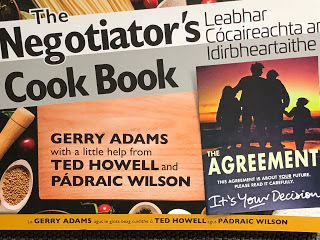
Published on February 21, 2020 04:04
February 20, 2020
Remembering Lily Fitzsimons – a proud United Irelander
 The Sinn Fein team going into City Hall. Lily Fitzsimons is flanked by Alex Maskey, Tish Holland, Sean McKight, ,
Fra McCann is hiding behind Alex; Paddy McManus, Joe O'Donnell, Sean Keenan, Mick Conlon and Joe Austin
Former west Belfast MP and Party President Gerry Adams has expressed his deep sorrow at the death of Lily Fitzsimons.He said: “I want to extend my deepest condolences and solidarity to the family of my friend and comrade Lily Fitzsimons. Like many other residents of Turf Lodge Lily was originally from North Belfast where she was born in 1937. After she married she moved to Turf Lodge.Lily’s politics were shaped by her family, her community, her class, her gender and her life experience. She was inspired by Máire Drumm and Marie Moore and the hundreds of women who daily challenged the actions of the RUC and British Army. In July 1970 she was one of thousands of women, led by Máire and Marie, who broke the British Army’s curfew of the Falls.She was a strong immensely able woman. She was a key activist in the Political Status campaign in the 1970s and during the subsequent Hunger Strikes when her son Sean was on the Blanket Protest. Lily, along with many other Turf Lodge mothers, sisters and wives took to the streets to highlight the conditions under which republican POWs were being held. She travelled widely to Britain and the USA to highlight the appalling conditions in the H-Blocks and Armagh Women’s Prison.The Relatives Action Committees took over buildings and blocked streets and when the British Army and RUC were sent in to beat them off the streets, the women faced them down. Lily said of that time: “We endured a lot of harassment and threats from the British Army and RUC during these times, but instead of intimidating us, it made us all the more determined to carry on.''In 1985 Lily was elected for the Upper Falls as a Belfast City Councillor along with Alex Maskey, Sean McKnight, Bobby Lavery, Sean Keenan, Gerard McGuigan and Tish Holland.It sparked a vicious campaign by unionist Councillors to deny Sinn Fein representatives any real say in the running of the council. Lily and her 6 comrades ran a daily gauntlet of physical and verbal threats and abuse. They were denied speaking rights in the Chamber. They were shouted down. Deodorant and other sprays were used against them.Lilly and Tish were especially targeted by some of the largely male unionist Councillors. But they never backed down. They fought their corner and represented those who elected them. Today Belfast City Hall is a different place because of the resilience of Lily, Tish and their comrades.Lily was hugely respected and loved. She stood strong in defence of her community at a time when Sinn Fein Councillors and activists and families were being attacked by unionist death squads. Three Sinn Fein Councillors and 14 party activists were killed during the time she was a Councillor. Family members were also killed when homes were attacked. Lily loved Turf Lodge and the people of west Belfast. She believed passionately in the rights of citizens and she brought that passion to all of her work.She was an unapologetic united Irelander. Awoman of compassion – who believed in equality and in citizens’ rights.Lily was also a wife, a mother, a grandmother. She was a writer who wrote insightfully of the role of women in the struggle. And she was a great singer whose party piece was Crazy by Patsy Cline. I want to extend my condolences to Sean, Bobby, Margo, Gerard and the wider family circle.
The Sinn Fein team going into City Hall. Lily Fitzsimons is flanked by Alex Maskey, Tish Holland, Sean McKight, ,
Fra McCann is hiding behind Alex; Paddy McManus, Joe O'Donnell, Sean Keenan, Mick Conlon and Joe Austin
Former west Belfast MP and Party President Gerry Adams has expressed his deep sorrow at the death of Lily Fitzsimons.He said: “I want to extend my deepest condolences and solidarity to the family of my friend and comrade Lily Fitzsimons. Like many other residents of Turf Lodge Lily was originally from North Belfast where she was born in 1937. After she married she moved to Turf Lodge.Lily’s politics were shaped by her family, her community, her class, her gender and her life experience. She was inspired by Máire Drumm and Marie Moore and the hundreds of women who daily challenged the actions of the RUC and British Army. In July 1970 she was one of thousands of women, led by Máire and Marie, who broke the British Army’s curfew of the Falls.She was a strong immensely able woman. She was a key activist in the Political Status campaign in the 1970s and during the subsequent Hunger Strikes when her son Sean was on the Blanket Protest. Lily, along with many other Turf Lodge mothers, sisters and wives took to the streets to highlight the conditions under which republican POWs were being held. She travelled widely to Britain and the USA to highlight the appalling conditions in the H-Blocks and Armagh Women’s Prison.The Relatives Action Committees took over buildings and blocked streets and when the British Army and RUC were sent in to beat them off the streets, the women faced them down. Lily said of that time: “We endured a lot of harassment and threats from the British Army and RUC during these times, but instead of intimidating us, it made us all the more determined to carry on.''In 1985 Lily was elected for the Upper Falls as a Belfast City Councillor along with Alex Maskey, Sean McKnight, Bobby Lavery, Sean Keenan, Gerard McGuigan and Tish Holland.It sparked a vicious campaign by unionist Councillors to deny Sinn Fein representatives any real say in the running of the council. Lily and her 6 comrades ran a daily gauntlet of physical and verbal threats and abuse. They were denied speaking rights in the Chamber. They were shouted down. Deodorant and other sprays were used against them.Lilly and Tish were especially targeted by some of the largely male unionist Councillors. But they never backed down. They fought their corner and represented those who elected them. Today Belfast City Hall is a different place because of the resilience of Lily, Tish and their comrades.Lily was hugely respected and loved. She stood strong in defence of her community at a time when Sinn Fein Councillors and activists and families were being attacked by unionist death squads. Three Sinn Fein Councillors and 14 party activists were killed during the time she was a Councillor. Family members were also killed when homes were attacked. Lily loved Turf Lodge and the people of west Belfast. She believed passionately in the rights of citizens and she brought that passion to all of her work.She was an unapologetic united Irelander. Awoman of compassion – who believed in equality and in citizens’ rights.Lily was also a wife, a mother, a grandmother. She was a writer who wrote insightfully of the role of women in the struggle. And she was a great singer whose party piece was Crazy by Patsy Cline. I want to extend my condolences to Sean, Bobby, Margo, Gerard and the wider family circle.
Published on February 20, 2020 07:21
February 13, 2020
Election 2020 – a tipping point
The votes have been cast and counted. Sinn Féin has emerged as the largest party by votes in the southern state. Over half a million (535,595) citizens gave their first preference to Sinn Fein. We have 37 seats in the Dáil.It was a remarkable election and an equally remarkable result. There had been a sense in the lead into the campaign that something was stirring within the electorate. The early opinion polls and the first canvas had indicated a greater than usual frustration at the Tweedledee – Tweedledum politics of the two larger parties of Fianna Fáil and Fine Gael. For four years Fianna Fáil worked in partnership with Fine Gael. Propping it up in government. Empowering its disastrous policies on health and housing. Echoing its lines against a Unity Referendum as set out in the Good Friday Agreement and outdoing its vitriol against Sinn Féin. And then, as if the electorate are fools, Fianna Fáil tried to tell citizens that it was different from Fine Gael. That it was the alternative. That it could deliver change. A con job.Last week, before a vote had been cast, I wrote of the “growing frustration and anger with the empty promises of the two bigger parties … anger at the willingness of Fine Gael and Fianna Fáil to protect the wealthy, the banking elite and the developers… anger at children made homeless and our elderly citizens and sick relatives languishing on hospital trolleys… anger at the witholding of state pensions to workers who have earned them.”I wrote also of the “anger at the Fianna Fail Leader Micheál Martin’s shrill political paranoia and hysterical ranting against Sinn Féin ...” and his insistence that “Sinn Féin is not fit to be in government.”All of this, and much more in recent decades, has seen a gradual process of realignment of electoral politics taking place in the southern state. This has been most evident in the diminishing vote of the two conservative parties who in the past could have expected to pick up over three quarters of the total vote. That share has been in decline for the last 30 years and this week Fianna Fáil and Fine Gael secured less than half (44%) of the total vote. In my column last week I pointed out that this process of realignment “has been slow and hesitant at times but that’s the way change happens. You work away, arguing, advocating, debating, organising and campaigning. At times with little visible results. Sometimes with setbacks or distractions. But you keep at it strategically, energetically, patiently and intelligently. You keep sowing seeds of resistance and hope and republican values. Seeds to grow alternative democratic dispensations. Egalitarian ideas. You never give up. You focus on the future. You believe. Then all of a sudden a tipping point emerges. Or a series of tipping points. The seeds grow. They flourish. They burst into flower. This election looks like being such an event.”And it was. And it is. I hesitated before publishing the above. What if the vote didn’t come out? What if the weather was too bad? What if …? But sometimes the pessimism of the intellect is superseded by the optimism of the will, and the certainty of instinct. So I’m delighted to say I told you so but while I expected Sinn Fein to do better than the usual naysayers and begrudgers were predicting I must admit I was pleasantly surprised by the strength of the vote. Why the increase for Sinn Fein at this time? In short, because people want change – real change. And they increasingly see Sinn Féin as the best vehicle for this.For our part Sinn Féin spent the recent months analyzing the failures of the Presidential election and our local government and European elections. We had an honest and thorough conversation which identified the flaws and the gaps and we then set about plugging them. As Mary Lou has said, we learned our lesson. We re-engaged with our base. The Ard Fheis was the first evidence of a refocused Sinn Féin. The by-elections, especially the election of Mark Ward in Dublin Mid West and the near election of Tommy Gould in Cork North Central were the first sign of recovery. John Finucane’s election was another positive, as was the end of unionism’s electoral majority and the establishment of the Northern Assembly.Our general election campaign in the South was very well run. Everyone was on message. The benefits of our outstanding Front Bench team on Finance, Health, Housing, the Environment and other issues alongside a strong team of TDs and Seanadóirí was visible everywhere. Mary Lou has played a blinder. We set the agenda.In Louth I told our activists that people, our voters, have the right to be critical of us. We need to listen to them and we need to have the confidence in ourselves to do that. If we did that I was certain that we would get Imelda Munster and Ruairí Ó Murchú elected. And we did. With style. Comhgairdeas Imelda agus Ruairí.The party also produced a manifesto for the future that is radical, costed and deliverable. A manifesto for Irish Unity, with solutions to the crises in health and housing, childcare and the environment and for rural Ireland. A manifesto which clearly captured the imagination and the hope of many.Sinn Féin’s success in 2020 has to be set in the context of the party’s strategy development over many years; the systematic building of political strength to advance our national objectives; the building of capacity and organizational structure within the party; and the recognition that republicans have to have a long headed view and that we have to be united and cohesive if we are to achieve our objectives. The outworking of our electoral progress was most obvious in the North following the hunger strike elections intervention in 1981. We now have 7 MPs, 105 Councilors, and 27 MLAs. Michelle O’Neill is the Joint First Minister. This expansion of the party was less obvious in the South. But careful strategic planning has also witnessed an upward trend in support in that part of the island. The general election results for the last twenty three years are evidence of this.· In 1997 Sinn Fein took 2.5% or 44,901. We won 1 seat.· In 2002 we took 6.5% or 121,020 votes. We won 5 seats.· In 2007 we took 6.9% or 143,410 votes. We won 4 seats.· In 2011 we took 9.9% or 220,661 votes. We won 14 seats.· In 2016 we took 13.8% or 295,319 votes. We won 23 seats.· In 2020 we took 24.5% or 535,595 votes. We won 37 seats.And we can win more in the future if we stay on course. Extra candidates would have left us the largest number of TDs in the Dáil. Hindsight is a great person to have at a meeting. And there you have it. Of course the most important issue is to use our political strength for the peoples’ benefit and to advance our cause.The focus now is on whether Sinn Féin can find a pathway into government. To achieve this we need a Programme fora Government for Change. It’s all about strategy. Knowing what you want to achieve. And mapping out a plan to get you there. We are currently in the national liberation phase of Ireland’s long struggle for freedom. We also have to right the economic and social inequities insofar as that can be done during the period of transition to a New Republic. Our manifesto is clear evidence that we can do both. So, we are with Connolly again - with the national and social elements of the struggle in primary focus.This election is a tipping point. Mary Lou has begun the work of speaking to other party leaders about agreeing a programme for government. The political landscape on the island of Ireland has changed.
Published on February 13, 2020 01:41
February 6, 2020
Be The Change You Want To See.
The general election in the South is drawing to a close. Polling day is Saturday – the first time an election has taken place on a Saturday since the historic 1918 election which saw Sinn Féin win a landslide victory. It has been a relatively short but very intense campaign. Many in the media tried to reduce it to a beauty contest between Fine Gael and Fianna Fáil. RTE went so far as to exclude Mary Lou McDonald from the Leader’s Debate. Then on the eve of the debate they reneged in the face of intense public outrage and Mary Lou, as she was entitled, debated with the Fianna Fáil and Fine Gael leaders. As in all of the other interviews and debates Mary Lou emerged head and shoulders above the other leaders. Meanwhile, notwithstanding my broken foot I have hobbled my way from door to door primarily in Louth where the republican effort is to re-elect Imelda Munster and elect Ruairí Ó Murchú – our Sinn Féin team in the wee county. There have been excursions into other constituencies as well. I have met hundreds of citizens. The feedback is the same everywhere. There is a growing frustration and anger with the empty promises of the two bigger parties, Fine Gael and Fianna Fail. Anger at their attempt to fabricate differences between themselves despite both parties having been in government together for the last four years. Anger at the willingness of Fine Gael and Fianna Fáil to protect the wealthy, the banking elite and the developers. Anger at successive governments for failing to hold these elites to account. Anger because they also are the elites. Anger at children made homeless and our elderly citizens and sick relatives languishing on hospital trolleys. Anger at the witholding of state pensions to workers who have earned them. Anger at insurance companies fleecing motorists and small businesses. Anger that citizens may have to work until their late 60s just to survive. One result of this and of opinion polls that have suggested a surge in the Sinn Féin vote was a tsunami of negative campaigning against the party by elements of the media and the two larger parties. Both Micheál Martin and Leo Varadkar attacked our manifesto commitments and especially our economic programme as ‘dangerous’. This, as Mary Lou retorted in one debate, was ironic given that a Fianna Fáil/Green Party government, in which Micheál Martin and Eamonn Ryan (the Green party leader) were Ministers, bankrupted the State, and a Fine Gael/Labour government imposed years of austerity with Fianna Fail support. There is also anger at Fianna Fail Leader Micheál Martins shrill political paranoia and hysterical ranting against Sinn Féin. There is annoyance that the North usually only gets mentioned by him and the Fine Gael Leader Leo Varadkar as part of their attacks on Sinn Féin. Those voters who are United Irelanders are very disappointed that both Fine Gael and Fianna Fail leaders have ruled out support for a referendum on Irish unity or a Citizens’ Assembly as part of a process to plan for this.So too with their insistence that Sinn Féin is not fit to be in government. That is seen correctly as a slight on Sinn Féin voters. Vintage yesterday Unionist rhetoric. Of course parties may not be able to agree a programme for government and it is difficult to see either Fianna Fail or Fine Gael supporting the type of republican programme for government proposed by Sinn Féin. That’s fair enough. But to insult a section of the electorate is unfair. Many people see that and they don’t like it. They also don’t like Fine Gaels plans to commemorate the RIC and Micheál Martin’s support for this. Patriotic citizens, regardless of their party politics, are proud of our revolutionary history. The Irish establishment is not. Most Irish people resent and reject that slíbhín approach. So southern electoral politics are going through a considerable process of realignment. This has been slow and hesitant at times but that’s the way change happens. You work away, arguing, advocating, debating, organising and campaigning. At times with little visible results. Sometimes with setbacks or distractions. But you keep at it strategically, energetically, patiently and intelligently. You keep sowing seeds of resistance and hope and republican values. Seeds to grow alternative democratic dispensations. Egalitarian ideas. You never give up. You focus on the future. You believe. Then all of a sudden a tipping point emerges. Or a series of tipping points. The seeds grow. They flourish. They burst into flower. This election looks like being such an event.If this election campaign has produced one message from voters it is that people want change – real and meaningful change. And many are looking beyond the tired ideas and failed policies of Fine Gael and Fianna Fáil. They’ve seen it all before and now they are actively looking for a viable alternative. Sinn Féin is that alternative. Sinn Féin is offering a genuine vision for change; to fix the housing crisis, reduce the cost of childcare, and give workers and families a break. We are for a government that works for Irish unity and for the people. Fianna Fáil and Fine Gael have had their chance. They have failed. In the last Dáil they smothered and suffocated any prospect of real change. Fianna Fails support for Fine Gael was a brake on that. Politics was more or less confined and reduced in that Do Nothing Dáil. But now the people will have their say on all that. Fine Gael and Fianna Fail are standing more candidates than us. We need to contest more constituencies with them. But that also will happen. It’s a long game but this cadre of republicans are long headed and in for the long run. It’s all about bringing about positive change. Planting seeds of resistance and republican values.This election could see the political landscape changing once again. It may not be as transforming as many of us want and as many citizens need, at this time. Fianna Fail could do better than the polls suggest. Some Fine Gael voters may swap to them to keep Sinn Fein out. And both Fine Gael and Fianna Fail are each standing more than double the number of Candidates that Sinn Fein is standing. Nonetheless change is coming. If you want that change, be the change you want. Micheál Martin and Leo Varadkar do not represent change. Mary Lou and the leadership team and Sinn Féin do. So on Sunday as the votes are counted we will see if the southern electorate agree. Ádh mór to all Sinn Féin candidates and activists and their families. Àdh mór to our leadership. And a word of thanks in advance to all Sinn Féin voters.
Published on February 06, 2020 02:12
January 30, 2020
The BannIng of Mary Lou
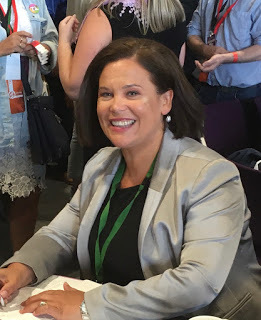 Sunday’s Business Post and The Irish Mail on Sunday opinion polls indicate a strong element of discontent with the politics of the two main conservative parties in the South – Fine Gael and Fianna Fáil. They are attracting less than 50% of the vote. Despite a succession of polls identifying the same trends – and we should always acknowledge that opinion polls don’t always get it right – RTE has chosen to exclude Sinn Féin President Mary Lou McDonald from its leader’s debate in the last week of the general election campaign.
Sunday’s Business Post and The Irish Mail on Sunday opinion polls indicate a strong element of discontent with the politics of the two main conservative parties in the South – Fine Gael and Fianna Fáil. They are attracting less than 50% of the vote. Despite a succession of polls identifying the same trends – and we should always acknowledge that opinion polls don’t always get it right – RTE has chosen to exclude Sinn Féin President Mary Lou McDonald from its leader’s debate in the last week of the general election campaign.Instead, like Virgin media last week, RTE’s ‘head to head’ will only involve Leo Varadkar and Micheál Martin – two leaders who have been partners in government for the last four years. Both parties published their election manifestos last Friday. TheJournal.ie reviewed them and concluded that “there are many ways the parties are broadly similar.” Professor Gail McElroy, from Trinity College Dublin, told TheJournal.ie that “historically there isn’t a clear difference between Fine Gael and Fianna Fáil, and their voters… They’re both centre-right parties and their fiscal policies are really not that far apart.”The same recent opinion polls suggest Sinn Féin is attracting significant support. Additionally, the evidence of the last four years in the Dáil demonstrates that is has been Sinn Féin’s team of TDs and Seanadóirí who have been the real and effective opposition to the Fine Gael/Fianna Fáil alliance. The decision therefore by RTE to present the formation of the next government as a straight choice between Varadkar and Martin is evidence of a blatant disregard of the Dáil realities and of its statutory obligations as the state’s public service broadcaster. RTE has a responsibility to behave in a fair, objective and impartial manner and to inform and educate citizens about the choices facing them. It clearly is not doing this in this leader’s debate.So, why this intransigent refusal to include Mary Lou McDonald in the debate? It is more than some hangover from the days of Section 31 and state control of the media news reporting. It is a mind-set – partitionism - within the political and media establishment which is rooted in our colonial history, in partition, in the counter revolution that took place after the Tan War, and in the establishment of two conservative states on the island of Ireland.It is the mind-set which was evident in the recent decision by Charlie Flanagan, the Minister for Justice, to commemorate the RIC and Dublin Metropolitan Police. Instead of being proud of our history of resistance and rebellion the political establishment is ashamed of it. This attitude is a symptom of the unfinished nature of the national struggle. It lies in our colonisation.That has shaped our character as a people. On the one hand there is the wonderfully humorous, subversive, never-give-up attitude of most Irish people who are fair and decent and are for freedom. But some, particularly those in power since partition in the Irish state, inherited the confused and conditioned traits of the colonised mind shaped by centuries of being governed by an imperial power. Liam Mellows, who participated in the 1916 Rising and was summarily executed by the Free State forces during the Civil War, put it well during the Treaty debate in 1922, when he spelled out the consequences of partition. He said: ‘Men will get into positions, men will hold power and men who get into positions and hold power will desire to remain undisturbed …’He was right. Partition saw a political establishment emerge in the South that settled for a 26 county state that stopped at Dundalk and Aughnacloy, at Belleek and Strabane and Derry. In the early days of the state Radio Athlone and then RaidióTeiifís Éireann refused to play popular republican songs, songs of the revolutionary period. Internationally renowned Irish authors were banned, including books by Liam O’Flaherty, Sean Ó Faolain, Frank O’Connor and Edna O’Brien and Brendan Behan, and many others
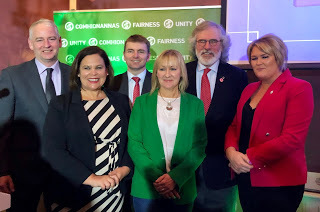 Cllr Tom Cunningham, Mary Lou McDonald, Cllr Ruairí Ó Murchú, Imelda Munster, Mise agus Joanna Byrne
Section 31, an obnoxious piece of legislative censorship, was introduced in 1971 by a Fianna Fáil Minister. It was later amended and a new order introduced by former Labour Party Minister Conor Cruise O’Brien in 1976. Under that order no interviews with anyone from Sinn Féin could be carried under any circumstances. Larry O'Toole, now a Dublin Councillor then a Trade Union official, was banned by RTÉ from speaking about a strike in Gateaux, a cake factory in Finglas north Dublin, where he worked. Others had similar experiences, including a Sinn Féin Councillor who witnessed a fatal fire in Bundoran but could not be interviewed as an eyewitness. In March 1988 Jenny McGeever broadcast a short clip of Martin McGuinness in a report she did for ‘Morning Ireland’ on RTE’s Radio 1 about the journey home from Dublin of the remains of the three IRA Volunteers killed at Gibraltar. She was immediately sacked. Sinn Féin voters from the north were also disenfranchised by RTE. After election victories newly elected SInn Féin MPs or councillors were ignored while our defeated opponents were interviewed. The same thing happened after serious incidents, including fatalities. British Army spokespersons were often interviewed! Sinn Féin never were. On other occasions in the 1970s and 80s songs were banned, including several by Christy Moore. These included ‘90 miles from Dublin’ and ‘The Time Has Come’ which dealt with Armagh Women’s Prison and the H-Blocks, ‘McIlhatton’ and ‘Back home in Derry’ (because they were written by Bobby Sands) and ‘They Never Came Home’ about the Stardust tragedy. I had my own run in with the RTE censors in1993 when RTE refused to carry an advert for one of my books – The Street and Other Stories. Conor Cruise O’Brien claimed in evidence to a court hearing the banning order that the book of short fictional stories were propaganda for the IRA. He claimed that the opening words would offend and corrupt the Irish public. “I have in mind,” he said, “the opening words: ‘This is Gerry Adams speaking.’ The court found against RTE. RTE appealed to the Supreme Court. It found in favour of RTE.In more recent times in September 2017 partitionism saw RTE mutilate the map of Ireland on the Late Late Show. Everyone in the North simply vanished into the sea with a new coastline running from Louth to Donegal. The north disappeared. This same image was first used by the Irish Embassy in Washington some years earlier as the Irish government has increasingly defined ‘Ireland’ or ‘the Nation’ as 26 counties. The Late Late Show often bans viewers from the north from its competition. Gaels in the north have difficulties watching or often not being able to watch Gaelic games on the self-proclaimed national broadcaster.There is also a symbiotic relationship between some senior elements of the media and the government of the day. Journalists regularly shift from their role as journalists to work for government Ministers, departments and political parties. This inevitably shapes and fuses the politics of both. Many in the political establishment in Dublin have never fully embraced the complete meaning of the Good Friday Agreement. While this accord has benefitted all of Ireland its positive equality focussed imperatives rarely penetrate south of the border. The Dublin establishment see it essentially as being about the north. The North remains for most a place apart – it’s up there – and this is then reflected also in how the political establishment deal with Sinn Féin.
Cllr Tom Cunningham, Mary Lou McDonald, Cllr Ruairí Ó Murchú, Imelda Munster, Mise agus Joanna Byrne
Section 31, an obnoxious piece of legislative censorship, was introduced in 1971 by a Fianna Fáil Minister. It was later amended and a new order introduced by former Labour Party Minister Conor Cruise O’Brien in 1976. Under that order no interviews with anyone from Sinn Féin could be carried under any circumstances. Larry O'Toole, now a Dublin Councillor then a Trade Union official, was banned by RTÉ from speaking about a strike in Gateaux, a cake factory in Finglas north Dublin, where he worked. Others had similar experiences, including a Sinn Féin Councillor who witnessed a fatal fire in Bundoran but could not be interviewed as an eyewitness. In March 1988 Jenny McGeever broadcast a short clip of Martin McGuinness in a report she did for ‘Morning Ireland’ on RTE’s Radio 1 about the journey home from Dublin of the remains of the three IRA Volunteers killed at Gibraltar. She was immediately sacked. Sinn Féin voters from the north were also disenfranchised by RTE. After election victories newly elected SInn Féin MPs or councillors were ignored while our defeated opponents were interviewed. The same thing happened after serious incidents, including fatalities. British Army spokespersons were often interviewed! Sinn Féin never were. On other occasions in the 1970s and 80s songs were banned, including several by Christy Moore. These included ‘90 miles from Dublin’ and ‘The Time Has Come’ which dealt with Armagh Women’s Prison and the H-Blocks, ‘McIlhatton’ and ‘Back home in Derry’ (because they were written by Bobby Sands) and ‘They Never Came Home’ about the Stardust tragedy. I had my own run in with the RTE censors in1993 when RTE refused to carry an advert for one of my books – The Street and Other Stories. Conor Cruise O’Brien claimed in evidence to a court hearing the banning order that the book of short fictional stories were propaganda for the IRA. He claimed that the opening words would offend and corrupt the Irish public. “I have in mind,” he said, “the opening words: ‘This is Gerry Adams speaking.’ The court found against RTE. RTE appealed to the Supreme Court. It found in favour of RTE.In more recent times in September 2017 partitionism saw RTE mutilate the map of Ireland on the Late Late Show. Everyone in the North simply vanished into the sea with a new coastline running from Louth to Donegal. The north disappeared. This same image was first used by the Irish Embassy in Washington some years earlier as the Irish government has increasingly defined ‘Ireland’ or ‘the Nation’ as 26 counties. The Late Late Show often bans viewers from the north from its competition. Gaels in the north have difficulties watching or often not being able to watch Gaelic games on the self-proclaimed national broadcaster.There is also a symbiotic relationship between some senior elements of the media and the government of the day. Journalists regularly shift from their role as journalists to work for government Ministers, departments and political parties. This inevitably shapes and fuses the politics of both. Many in the political establishment in Dublin have never fully embraced the complete meaning of the Good Friday Agreement. While this accord has benefitted all of Ireland its positive equality focussed imperatives rarely penetrate south of the border. The Dublin establishment see it essentially as being about the north. The North remains for most a place apart – it’s up there – and this is then reflected also in how the political establishment deal with Sinn Féin.
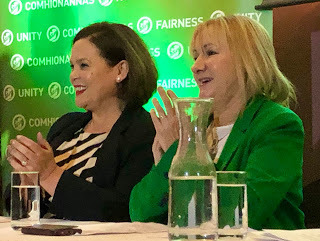 This is part of the context for the exclusion of Mary Lou from the leader’s debate. It is also the mind-set which saw Fine Gael, supported by Fianna Fáil leader Micheál Martin, decide to commemorate paramilitary forces – the RIC and Dublin Metropolitan Police – that had violently sought to prevent the Irish people achieve freedom. The reality is that neither the Fine Gael or Fianna Fáil leaderships are about promoting Irish Unity. But they recognise in Sinn Fein a party that is committed to unity and consequently a party to be marginalised, excluded and banned. There are many decent, fair and objective broadcasters in RTE. There are many good journalists. They also need to speak out on these issues. Or does a culture and a history of censorship make that too awkward or challenging a question.
This is part of the context for the exclusion of Mary Lou from the leader’s debate. It is also the mind-set which saw Fine Gael, supported by Fianna Fáil leader Micheál Martin, decide to commemorate paramilitary forces – the RIC and Dublin Metropolitan Police – that had violently sought to prevent the Irish people achieve freedom. The reality is that neither the Fine Gael or Fianna Fáil leaderships are about promoting Irish Unity. But they recognise in Sinn Fein a party that is committed to unity and consequently a party to be marginalised, excluded and banned. There are many decent, fair and objective broadcasters in RTE. There are many good journalists. They also need to speak out on these issues. Or does a culture and a history of censorship make that too awkward or challenging a question.
Published on January 30, 2020 08:23
January 26, 2020
Go raibh maith agat Máirtín
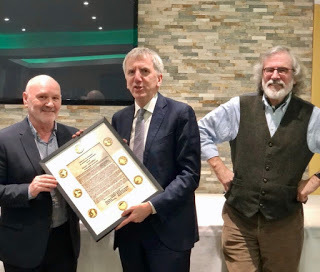 Recently, after almost three decades as an elected representative - first as a Councillor on Belfast City Council and then in the Assembly – Máirtín Ó Muilleoir announced his decision to step back from the Assembly and from electoral politics. Last Friday night Shinners and friends in south Belfast got together to thank Máirtín for his years of activism and I was pleased to join them.
Recently, after almost three decades as an elected representative - first as a Councillor on Belfast City Council and then in the Assembly – Máirtín Ó Muilleoir announced his decision to step back from the Assembly and from electoral politics. Last Friday night Shinners and friends in south Belfast got together to thank Máirtín for his years of activism and I was pleased to join them.As our first Councillor into Belfast City Council Alex Maskey told how he first met Máirtín when he was an activist during the hunger strike campaign in 1981. He also recounted several very funny stories of Máirtín’s early experience with unionist Councillors who were determined not to treat Sinn Féin Councillors with respect. When it came my turn I acknowledged Helen, who provided much need support to Máirtín during all of the difficult days.Máirtín is now joining an illustrious band of former Sinn Féin elected representatives including Martin Ferris, Caoimhghín Ó Caoláin, Danny Morrison, Bairbre de Brún, myself and others who have stepped to one side to allow others to come forward.Máirtín first stood as a Council candidate in 1985. On that occasion he was unsuccessful but two years later he won a by-election and joined the growing team of Shinners in the City Hall.Máirtín recounted his experiences in the City Hall in his book “The Dome of Delight”. The Council then was a very different place. In the years following the election of Alex in 1983 and Sean McKnight in 1984 the unionist parties sought to bully and intimidate republican Councillors.Sammy Wilson described the Sinn Féin Councillors as "evil gunmen (he refused to recognise mna na héireann) who had crawled out of west Belfast" and he vowed to ostracise them. Unionists refused to talk to them, except to call them names. They refused to allow them to speak in the Council or to raise constituency issues. They tried to shout Sinn Féin Councillors down; deny them speaking rights; blew rape whistles and blew horns and sprayed deodorant on to them. They also refused to invite Sinn Fein Councillors to Civic events. That led to alternative people’s openings of civic buildings, like the Whiterock Leisure Centre.
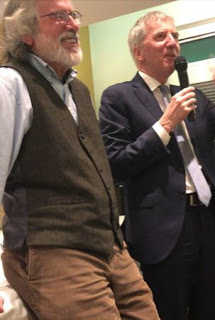 The unionist parties went so far as to establish illegal sub-committees to carry out the work of the Council which excluded Sinn Fein members from the decision making process. They refused to allow them to sit at the table where committee members sat to carry out their business. They tried to insist that Sinn Féin Councillors sit at the back of the room when some of these committees were meeting. Fra McCann put a stop to that. No sitting at the back of the room for him. He sat at the table and no one could shift him.Sinn Féin Councillors were regular targets for unionist paramilitaries. Alex was shot. His friend Alan Lundy was shot dead in Alex’s home. Bobby Lavery’s home was attacked and his son Sean killed. The home of Jim Clinton who had been a Council candidate for Sinn Fein was attacked and his wife Theresa was killed. And there were others across the North and Eddie Fullerton in Donegal who were killed and wounded. Sheena Campbell was murdered not far from where we meet this evening.
The unionist parties went so far as to establish illegal sub-committees to carry out the work of the Council which excluded Sinn Fein members from the decision making process. They refused to allow them to sit at the table where committee members sat to carry out their business. They tried to insist that Sinn Féin Councillors sit at the back of the room when some of these committees were meeting. Fra McCann put a stop to that. No sitting at the back of the room for him. He sat at the table and no one could shift him.Sinn Féin Councillors were regular targets for unionist paramilitaries. Alex was shot. His friend Alan Lundy was shot dead in Alex’s home. Bobby Lavery’s home was attacked and his son Sean killed. The home of Jim Clinton who had been a Council candidate for Sinn Fein was attacked and his wife Theresa was killed. And there were others across the North and Eddie Fullerton in Donegal who were killed and wounded. Sheena Campbell was murdered not far from where we meet this evening.Our offices, including the office in the City Hall, were bombed. Many Sinn Fein Councillors wore flax jackets going into and out of the one entrance into the City Hall. They varied their routes and were always mindful of the dangers they faced.
This was political environment when Máirtín and Fra were elected in November 1987 to the Council. Like the northern state that was founded in 1920 Belfast City Council was a place apart – an apartheid Council – representing an apartheid city separated into ghettoes in which nationalists and republicans were expected to meekly accept the crumbs from the table and keep quiet.
When Máirtín rose to make his first speech he opened with “Ba mhaith liom buíochas a thabhairt do na daoine a thug vote ...” That was as far as he got before Sammy Wilson jumped to his feet and demanded he be stopped. Unionists immediately raised their hands in support of a motion that he should not be heard. That’s when Máirtín began his second sentence.
There was that much noise from the unionist benches that no one could hear what he was saying but they knew it was in Irish. Sammy Wilson was apoplectic. He shouted that Irish was a ‘leprechaun language’. He called on the unionist Lord Mayor, Dixie Gilmore, to discipline Máirtín who the unionists tried to ridicule because he refused to use the English version of his name. The RUC were called. Máirtín was evicted from the chamber for what was described as disruptive behaviour.
It took years and a whole series of legal actions and injunctions in the courts but gradually undermined the unionist efforts to marginalise the Sinn Féin Councillors.Máirtín and Alex and the other Sinn Féiners stood their ground; defending republican politics and standing up for our constituents and their rights.We were determined that Belfast should be “Our City Also” and through the leadership of Alex and Sean McKnight and Lilly Fitzsimons and Tish Holland and Máirtín and many others they gradually broke down the barriers to equal representation in the Council.We also broke the ban on nationalist marches taking place into the city centre.Máirtín was a Councillor until 1997 and then took up full time work managing the Belfast Media Group and is the publisher of the Irish Echo in New York. He came back onto the Council in 2011 and in 2013 he followed in the footsteps of Alex and Niall when he became the City’s First Citizen. He was attacked by thugs in Woodvale Park while performing his duty as Ard Mheara but undeterred he was back out in the neighbourhoods almost immediately afterward.As a business person Máirtín brought a very acute sense of the needs of business in Belfast to the Office of First Citizen and he championed equality, especially for Irish language speakers. He also actively promoted the Arts. In 2014 Máirtín was co-opted onto the Assembly and two years later he was appointed Minister for Finance.
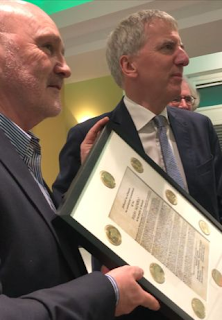 Máirtín has boundless energy – he never stops – literally. He is a human Duracell bunny – a Billy whiz. He is forever running marathons or galloping along the Lagan tow path or some other place.He has been a tireless advocate for Belfast; for the North and for Irish Unity. He has developed and strengthened links with our diaspora, especially in north America. He has been involved in countless initiatives to promote Belfast; education; the Irish language and culture and business. The Aisling Bursaries awards is just one example of this.Máirtín has been a formidable elected representative. He stands against bigotry and sectarianism and is determined to make Belfast a better place for all its citizens. I want to commend him for his leadership and his contribution to creating a new Belfast. Many thanks to Helen and Máirtín’s family for all that they have done and best wishes for all that they do in the future.
Máirtín has boundless energy – he never stops – literally. He is a human Duracell bunny – a Billy whiz. He is forever running marathons or galloping along the Lagan tow path or some other place.He has been a tireless advocate for Belfast; for the North and for Irish Unity. He has developed and strengthened links with our diaspora, especially in north America. He has been involved in countless initiatives to promote Belfast; education; the Irish language and culture and business. The Aisling Bursaries awards is just one example of this.Máirtín has been a formidable elected representative. He stands against bigotry and sectarianism and is determined to make Belfast a better place for all its citizens. I want to commend him for his leadership and his contribution to creating a new Belfast. Many thanks to Helen and Máirtín’s family for all that they have done and best wishes for all that they do in the future.
Published on January 26, 2020 03:14
Gerry Adams's Blog
- Gerry Adams's profile
- 29 followers
Gerry Adams isn't a Goodreads Author
(yet),
but they
do have a blog,
so here are some recent posts imported from
their feed.



